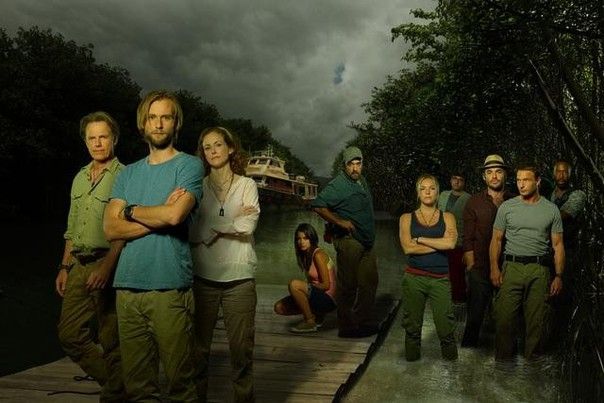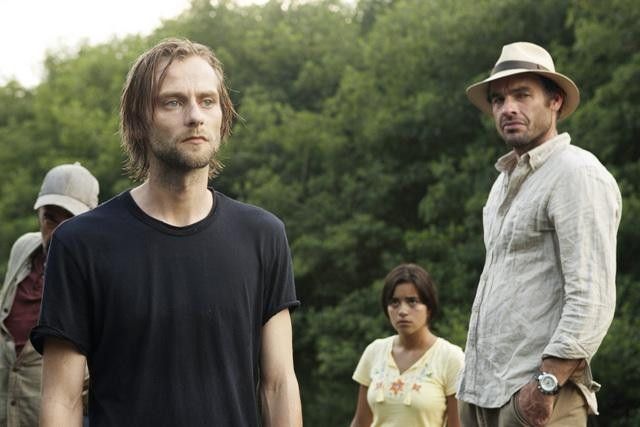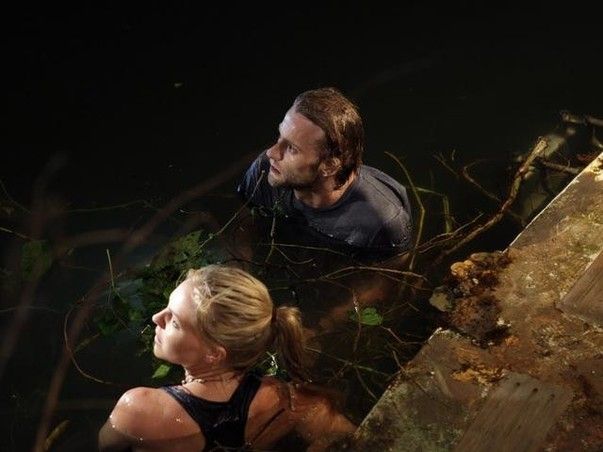In ABC’s new horror series The River, unhappy rescuers head deep into the Amazon, fighting monsters, spirits and each other as they search for Dr. Emmet Cole (played by Bruce Greenwood), a beloved wildlife documentarian gone missing while filming his TV show. Six months after he'd been given up for dead, Emmet’s GPS locator suddenly turns on, prompting his obsessive wife Tess (Leslie Hope) and estranged son Lincoln (Joe Anderson) to organize an expedition to find him.
Along for the ride are Emmet’s ex-producer Clark (Paul Blackthorne) and his camera crew, brought along to document their travels and fund their venture. However, the group soon discovers nature-loving Emmet has been messing with forces most unnatural, and the search brings them face to face with the magical creatures stirred up in Emmet’s wake.
The brainchild of Paranormal Activity director Oren Peli and Paranormal Activity 2 screenwriter Michael R. Perry, The River brings the horror franchise’s signature found-footage documentary style to television. It's an ambitious feat that executive producers Michael Green and Zack Estrin believe is also The River’s greatest asset.
“I think people are hungry for the thing that is different,” Estrin told Spinoff Online. Highlighting comparisons between The River and Lost, he continued, “It’s an interesting thing to say because what made Lost a hit wasn’t necessarily what it was about, it was just the fact that it was a different show.”
“They can’t guess ahead of time how it’s going to turn out,” Green agreed, explaining that aspect is something that applies to The River as well.
Premiering tonight on ABC, The River marks more than just another TV drama: It’s the duo’s chance to challenge and change the way mainstream television is made.
“Network television abhors major change,” Green explained. “It’s very good at doing something it’s been doing for a very long time, and it’s not because the people involved aren’t smart or dedicated, it’s just an institution. It’s hard to get anything to move, and we’re trying so hard, especially with The River, to do something that really hasn’t been done before.”
When Green says their aim is "to do something that really hasn’t been done before," he means it: The River is dedicated to authenticity, and the producers refuse to show any action or scene that couldn't be captured by a camera operator, pushing the envelope of what a network can broadcast. An example that sprang to mind for Estrin was a recent discussion he had with network executives about how loud and how bright the show appears.
“In certain spots it looked ‘too bright,’ and they say they don’t know what would happen if they sent this broadcast signal out -- their equipment might cut it off, it might go blank, they have no idea,” he said. “You know how everyone always says, ‘We’re trying to think outside the box and do something different?’ There’s a literal box that’s for sound to actually fit into, and occasionally on our show the little dial goes out of the box -- literally, there is a box and they have to put us back into this box!”
“When you try to do something crazy ambitious with 12 cameras running from ghosts, things get complicated!” Green laughed.
While The River is undeniably ambitious, it's not alone in bringing horror to the small screen: Series like AMC’s The Walking Dead and FX’s American Horror Story are performing well, something Green and Estrin again attributed to the changing network and cable TV landscape.
“I think we’re in an era where there’s so much television and so much experimentation on cable that writers are finally getting a chance to do stuff they’ve wanted to do for a long time instead of being forced at gunpoint to do the same things over and over again,” Green said. “ I can’t tell you how many times we were staffing the show, or just talking about it, and people would say, ‘This is my favorite genre and I never get to watch it on TV, I never get to write it.’”
“For the first time in a while people are open to trying new things,” Estrin agreed. Quick to point out that this also applied to studio and network executives, the two said they were often surprised and gratified by how willing ABC was to embrace the high-concept show.
“The people at the studio and network really wanted to go for it, they didn’t want the soft version of the show they wanted the aggressive version of the show," Estrin said. "I think networks are taking bigger swings now, and if the audience comes and supports that they will continue to do so."
Although many of the strange creatures utilized for The River's "monster of the week"-type plots are fictional, the producers said all of them have roots in South American folklore.
“When we were beginning our show everybody was assigned to come in with research on things that you found of true legends and lore and scary things from down in South America,” Estrin said.
Acknowledging they've yet to establish a "gimmick," the two emphasized that every creature and spirit the characters encounter is different, and that variety is the key to keeping the story fresh.
“In essence [monster of the week] is a little bit of our formula, but it’s not always a monster," Estrin said. "There’s something bad that happens every week, but it’s not going to be, ‘Oh, look, it’s the demon of the this, today it’s the demon of the that!’ There’s a lot of things that can scare you, so we will not fall into a pattern you will get bored of."
The two were also cautious about overusing camera point of view to scare the audience, seeking to make sure every shot is justified and nothing was out of the realm of a real cameraman, or camera-mounted hexacopter used in the show.
“Cameras react," Green said. "It’s a game we play. We had to be just as cautious to not overdo camera gags as to do them ... not be so clever with it that it becomes a distraction."
While tonight’s two-hour premiere was shot in Puerto Rico, the rest of the series was filmed in Hawaii, where an existing crew base and jungle enivornment perfectly suited for the show’s needs. However, the island state did have one drawback.
“It did not, as Zack likes to remind us, have a river, which turns out to be the title of the show!” Green laughed. Instead, the producers found an inlet, which they used to simulate the river, shipping in flora native to the Amazon to dress scenes and give the location an authentic feel.
With a horror show like The River, Green and Estrin knew the first order of business was to figure out how to make each episode genuinely frightening. One way the two found effective was to play up the suspense.
“We wanted to celebrate silence in our show," Green said. "Often it’s the silence before the crazy that’s the most terrifying."
Having a drama in which large stretches of time are spent in silence was another big risk for network television, but again one that ABC quickly embraced, utilizing the silent shots for the show’s promos. “It was a big change for network and studio for us to say we want to do a show where the scariest thing is what’s about to happen,” Green said.
“In a strange way there’s a similar challenge in this that there is in comedy in that everybody thinks different things are funny,” Estrin said. “For some people this show will be truly scary, to some people it will be truly suspenseful but not scary. The trick for us was to find a kind of scare that would hit different parts of the audience in different ways.”
After hours talking to each other about what they found scary, Green said they discovered one thing that is, without a doubt, universally frightening.
“I think everyone in the world thinks it’s really scary when ice cream trucks have the music playing but the music starts going slow and creaky,” he joked, adding in mock horror, “That creepy clown music!”
“The guy who drives around in the ice cream truck must not think it’s scary, I don’t know how they do it!” Estrin added.
Besides the shooting and scare challenges, Green and Estrin also were faced with trying to write a family drama into a horror premise.
“It is very difficult to talk about your relationship with your mother while you are running away screaming,” Green admitted. To get around this, Green, Estrin and the writers focused on what they deemed the “quiet moments” in the story, creating poignant lulls in action.
“In a lot of those horror movies you don’t need to care about the people because in a way you kind of want to enjoy their demise," Estrin said. "So you create archetypes of people: here’s the asshole, here’s the loudmouth, here’s the whore."
“And then it’s fun watching them get picked off because it’s so generic,” Green chimed in.
“But for us we need to find a reason for people to keep coming back week after week, and so you have to get people to invest in these characters and root for them not to die,” Estrin continued.
This revelation led to the creation of the dysfunctional Coles, from absentee father Emmet to deeply flawed and angry Lincoln, who reluctantly heads the recovery expedition.
“That was one of my big pitches to the studio network when they asked me if I wanted to come aboard," Green recalled. "I said, ‘Yeah, I think you can do something here but I think you need to change the family dynamics and make them troubled, make this family in a little bit of a personal crisis, not just because of the missing person but also because they are not in a good place so we could watch them grow.' It was a somewhat divisive decision but it really helped by giving us a lot to play with in characters.”
Ultimately, the two believe that what sets The River apart is the unique nature of what they're trying to accomplish: a challenging and horror-filled network drama shot in a documentary-style that feels authentic and earns every scream.
“I always liked things that were difficult and challenging, and when I read Michael’s script I went, ‘Well this looks really hard, let me do that!’" Estrin said. "Because who wants to just do doctor, lawyer, cop [shows]? We’ve all done it before."
The River premieres tonight at 9 ET/PT on ABC.




